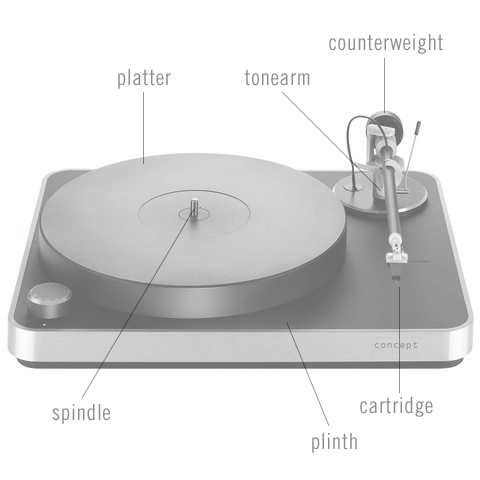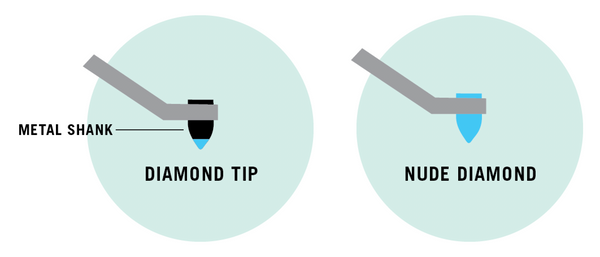
Guide To Audiophile / HiFi / Turntable Terminology
You want to get into vinyl and sound quality matters to you. You're an ex-DJ who wants to make use of the record collection with a new listening setup. You're into design and want the right aesthetic in your audio setup. When you start shopping for turntables, you'll start to see the term "Audiophile" and "High Fidelity / Hifi" quite abstractly and liberally. What does it mean? What are all these terms associated with it? Go into some audiophile forums, and you might end up being more confused than before. This guide is a practical introduction to the terminology generally used to describe audiophile turntables.
 NOTE: This is not a guide for audiophiles (if you want to get super-technical, check out Audio Asylum or Reddit’s Forum). Rather, it's an entry point for someone who wants to get familiar with the terminology used.
NOTE: This is not a guide for audiophiles (if you want to get super-technical, check out Audio Asylum or Reddit’s Forum). Rather, it's an entry point for someone who wants to get familiar with the terminology used.
What is an Audiophile anyway?
What is an audiophile?
Webster's Dictionary: "A person who is enthusiastic about high-fidelity sound reproduction."
What's high-fidelity?
For simplicity, we'll break it down like this. To enjoy a high-fidelity sound experience, you'll need:
- the original source music needs to be recorded in a high quality fashion (eg. recording equipment, studio, sound engineer)
- that recording needs to mastered and pressed (whether CD or vinyl) to very high audio standards (eg. direct from master tapes, pressed on quality vinyl)
- to play your recording, you should use a high quality audio system that plays the music cleanly and accurately (eg. faithful to that original high quality recording)
- basically, in layman's terms, you want both high quality process, ingredients and equipment in order to get the most out of your audio experience.
- over the years, "HiFi" has come to mean quality audio components that are a couple levels above consumer audio or what you'll find at a big box retailer.
What makes a turntable audiophile or Hi-Fi?
In our opinion, an Audiophile turntable is a turntable that is designed to optimize sound quality and sound character of the vinyl record. These turntables are generally a step above in quality and price of the mass-produced, usually plastic-bodied turntables.
How does an audiophile turntable do this optimization thing?
- Audiophile turntables are designed to operate as accurately and smoothly as possible.
- The platter and motor will spin with minimal to no variation in speed or platter position (technical term: reducing wow and flutter).
- The tonearm will operate with the lowest amount of friction possible and be adjustable to best work with your cartridge.
- The turntable motor will operate creating a minimal amount of vibrations / resonance.
- The turntable will have built-in mechanisms to dampen / absorb unwanted vibrations created by the motor.
- This "pure" environment allows the needle to pick up the grooves in the record most accurately with minimal outside interference.
That look. Audiophile turntables tend to be minimalistic and singular in design. They tend not to have built-in features such as auto-change, pitch control, buttons, lights, etc... but there are always exceptions. The unofficial design ethos of audiophile turntables is: if it doesn't directly improve the basic sound performance of the turntable, don't include it.
Why don't these turntables have built-in speakers?
Audiophiles prefer their speakers to be on a separate unit to reduce resonance / feedback. If your speakers and turntables are combined or even on the same piece of furniture, the vibration from the speakers will negatively affect sound quality. That's why many serious sound systems utilize speaker stands or wall mounts.
Pricing? Affordable?
In terms of pricing, audiophile turntables range widely and don't fit into real world definitions of "cheap" and "expensive." Since when is a $400 turntable cheap? In the audiophile world, it is. In general terms, entry level turntables range between approximately $300-$500. Mid-range turntables go for approximately $500-$1500 (yes, $1500). High end audiophile turntables range from $1500 to over $100,000 (no joke, the Clearaudio Statement Turntable goes for over $150k).
Glossary of Commonly-Used Turntable Terms
Resonance / Rumble / Vibrations / Reverb / The Shakes
The enemy of high-fidelity sound. Basically, these are unwanted vibrations that effect the performance of the needle in the groove of the record. These enemies can be created by many things including the parts of your turntable, the turntable motor, the bass from the your speakers, your dog, etc. You want to fight these guys.
Dampen / Damping / Dampening
To absorb or weaken vibration... a way to fight the enemy. Audiophiles have many ways to dampen vibrations. The main way is the use of rubber and other materials such as Sorbothone. Other methods include decoupling (see below), special dampening parts (special shock absorbing turntable feet), and other fun accessories (record clamps, record mats, etc).
Plinth / Chassis
This is the body of your turntable. Many audiophile turntables are made of a wood material called MDF.
MDF
Medium density fiberboard. A wood material used for many audiophile turntable plinths and some platters. It is heavy, durable, and absorbs vibration more than metal.
Platter
This is the circular base that the record spins on. It is made of various materials including metal or acrylic. You want your platter to be rigid with a nice weight to it.
Bearing
There are two main bearings in a turntable. The first bearing is found in the motor at the base of the spindle (that metal knob that sticks out of the platter). The other is found at the base of the tonearm. You want these to be high quality bearings that perform with a minimum amount of friction. Audiophile turntables generally use teflon bearings for smoother performance.
Decoupled / Decoupling
Decouple = to separate / disengage. Audiophile turntable design utilizes decoupling, which basically means that mechanisms that can interfere with each other (for example: a vibrating motor and a platter that's not supposed to vibrate) are placed in positions that will minimize the effect on each other.
The main decoupling that occurs on a turntable is between the tonearm and the motor. The tonearm is directly affixed to the plinth, while the motor is connected to the plinth by a suspension system. On some of the more expensive turntables, decoupling can be taken further. The plinth will be built with multiple layers (think a layer cake) with the motor suspension attached to the one of the bottom layers, and the tonearm on a separate top layer.
Belt-Drive / Pulley
Belt-Drive refers to the design of the turntable pulley system that uses a motor to turn a pulley, which turns a rubber belt, which turns the turntable platter. Belt-drive turntables are preferred for audiophile turntables for a couple reasons. First, the motor and platter are decoupled (on direct drive turntable the motor is directly connected to the platter). The belt system serves as the intermediary, absorbing and diffusing the vibration that's created naturally by the motor. In our opinion, belt-drive’s superiority over direct drive is debatable.
Direct Drive
Direct Drive turntables feature a motor that is integral (directly connected) to the platter (via the spindle). It does not use a pulley system. Direct Drive turntables like the Technics 1200 are magnetically driven, which allows you to stop the platter manually without damaging the motor. For this reason, Direct Drive turntables are used for DJing.
Interconnect
This is the cable that connects your turntable to your pre-amp or output amp. Also known as a RCA cable.
BONUS: Some Needle / Cartridge Terminology
What's the difference between stylus, needle and cartridge?

Cartridge refers to the entire mechanism including the stylus. Stylus is the removable part of the cartridge which includes the tip, cantilever and attaching piece. Stylus and needle are the same thing.
MM Catridge vs MC Cartridge / Moving Magnet Cartridge vs. Moving Coil Cartridge
First of all, Moving Coil (MC) cartridges should only be purchased by advanced users. They're generally MUCH more expensive, more fragile, and sometimes need special amps / pre-amps. In addition, when it's time to replace a Moving Coil stylus, you usually have to send it to the manufacturer.
For nearly all purposes, a Moving Magnet (MM) is what we recommended. Most cartridges on the market are Moving Magnet, and they come in a full range of quality and price. For most users, it will be hard to tell the difference between similarly-priced MM and MC cartridges. If you've read this far down this beginner's guide, we suggest just forgetting about MC cartridges for now (maybe it will call out to you later).
Spherical vs. Ellipitical Stylus
 Elliptical stylus is the more expensive, better sounding option. Because of its shape, elliptical styluses follow the record groove oscillations more accurately. For home listening, elliptical styluses are recommended.
Elliptical stylus is the more expensive, better sounding option. Because of its shape, elliptical styluses follow the record groove oscillations more accurately. For home listening, elliptical styluses are recommended.
However for some forms of DJing, the spherical stylus is recommended. During heavy scratching and back-cueing, a spherical stylus will lead to less record wear than a elliptical stylus. However, many DJs (especially house / dance DJs) still use elliptical styluses.
What's a Diamond Tip Cartridge?
Diamond refers to the material of the stylus tip. Yes, many cartridges feature small diamonds on the tip of the stylus. Generally, for your main turntable, you want to stay away from ceramic tip cartridges. Ceramic tip cartridges are durable, but cause lots of record wear and don't sound as good.
Tipped / Bonded Diamond vs. Nude Diamond Stylus

Tipped diamond is what is found on most cartridges. The diamond is a cap that is glued to a metal shank which is connected to a stylus cantilever. Nude diamond features a larger diamond and forgoes the metal shank. With a nude diamond, listeners will hear clearer extension of high frequencies with less sibilance and better retrieval of subtle details. The reason for this is that the nude diamond weighs significantly less than a bonded-type, so the grooves of the record will move the diamond more easily. Nude Diamond cartridges are much more expensive. For an example, check out Ortofon's 2M Red (diamond tip) vs Ortofon's 2M Blue (nude diamond).
Anti-Skating
Due to the way a record plays in a circular motion, it pulls the cartridge toward the center label of the record. The natural force causes the cartridge to cheat, favoring one side of the record groove. Anti-skating is an adjustment that helps balance the stylus in the groove. With properly adjusted anti-skating, it compensates for inward force and helps the stylus ride the center of the record groove.
Standard Mount vs. P-Mount + Headshell

Cartridges mount to your tonearm in (2) main ways. Standard Mount connects to your tonearm via (2) screws. Most turntables and cartridges are designed to take Standard Mount. P-Mount plugs directly into a tonearm using a (4) plug system. P-Mount cartridges are generally reserved for beginner / economy turntables because they are easy to install and replace. However compared to Standard Mount cartridges, P-Mount cartridges are not as adjustable and the quality is usually lower.
\

